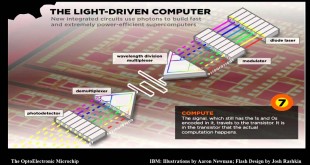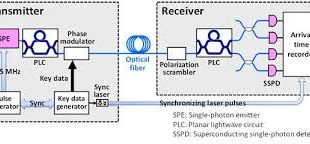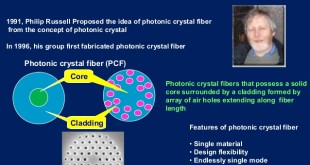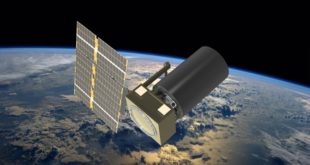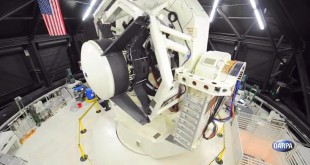The drones have emerged as a major new threat to civilian infrastructure and military. Counter-drone technology, also known as counter-UAS, C-UAS, or counter-UAV technology, refers to systems that are used to detect and/or intercept unmanned aircraft. One of the attractive Anti-drone weapons have been directed energy weapons (DEWs) both of …
Read More »Terahertz Photonics breakthroughs promise ultrahigh speed communication systems to medical imaging and diagnostics, industrial quality control, and security screening
Terahertz (THz, 1012 Hz) technology is based on light sources with frequencies much lower than of visible light, and slightly higher than of microwaves. Such light sources have a number of unique capabilities, for example that it can propagate through most insulating materials such as paper, plastic, cardboard, clothes etc., …
Read More »Optical processors for high performance and energy efficient computing for data centres and supercomputers
Moore’s Law which stated that the number of transistors on a chip will double approximately every two years has been the driver of semiconductor industry in boosting the complexity, computational performance and energy efficiency while reducing cost. The increase in computing performance of electronic computers is becoming more and more …
Read More »Graphene enables room temperature single photon emitter and detector for unhackable Quantum Key Cryptography (QKD)
Quantum Key Distribution, or QKD, enables two remote parties, “Alice” and “Bob”, who are connected by a passive optical link to securely generate secret key material. Single-photon sources (SPSs) and single-photon detectors (SPDs) are key devices for enabling practical quantum key distributions (QKDs). Single photon generation is necessary for secure quantum transmission; …
Read More »Optical Circulators are building blocks for chips for optical communication networks and quantum computers
Fiber optical circulators are used to separate optical signals that travel in opposite directions in an optic fiber in order to complete bidirectional transmission. Optical circulators are also known as non-reciprocal optics, which means when the light travels in the opposite direction, changes in the light properties are not reversed. …
Read More »Hollow-core optical fibers enable secure communications in data centers, accurate sensing gyro for Aerospace applications
Conventional optical fibers are fabulously successful, but they have profound limitations. They contain a glass core at the center of the fiber through which light is transmitted. However, not only does this glass center limit the speed of the light as it passes through, but it also adversely affects other …
Read More »Solar fiber optic lighting for daylighting of high-rise intensive buildings and military shelters
Conventional daylighting scheme employing windows and skylights are no longer so useful especially for daylighting of high-rise and intensive buildings. Residential buildings with limited natural lighting are generally lit by fuel-based electricity which contributes to increase of CO2 concentration in the atmosphere. Alternatively, the concentrated solar energy can be transmitted …
Read More »DARPA DeMi developing technologies for space based telescope on it’s military CubeSat satellite for Space Surveillance Awareness
The volume of space between the Earth’s surface out to geosynchronous orbit is enormous—equivalent to 240,000 times all the Earth’s oceans. Yet the number of objects calling that volume home is growing all the time—not just with satellites but with debris of all kinds, natural and manmade. And keeping track …
Read More »DARPA operationalizes Space Surveillance Telescope in Australia, earlier handed over to Air Force Space Command to protect satellites from orbiting junk and space weapons
A U.S.-developed space surveillance telescope has been assembled at a new facility in Western Australia and is expected to start operating in 2022, the U.S. Space Force Space and Missile Systems Center announced April 2020. The telescope, designed to track and identify debris and satellites more than 22,000 miles above Earth, …
Read More »Hybrid Free Space Optics (FSO)/Radio Frequency (RF) communication systems can improve the performance of Free space optical communications
Free-space optical communication (FSO) is an optical communication technology that uses light propagating in free space to wirelessly transmit data for telecommunications or computer networking. “Free space” means air, outer space, vacuum, or something similar. FSO operates on the Line-of-Sight phenomenon, consisting of a LASER at source and detector at …
Read More » International Defense Security & Technology Your trusted Source for News, Research and Analysis
International Defense Security & Technology Your trusted Source for News, Research and Analysis

